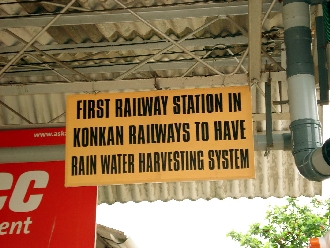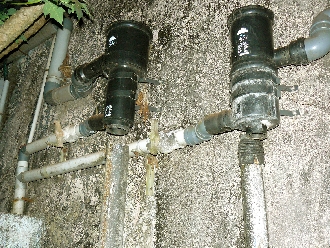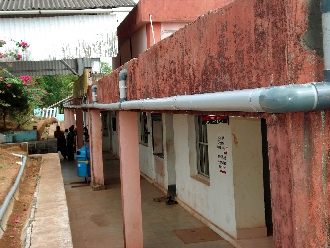Ankola is a small railway station in Konkan Railway route. This Karnataka coastal town in Western Ghats falls under heavy rainfall area. In fact, this area of the state enjoys an average rainfall of 3,500 mm. Despite that, this station figures big in water scarce railway stations of this route. The department spends Rs.75,000 a year on outsourcing water for this tiny station.
Since 1998, when services along this route was launched, this station has no public water supply. It requires about 7,000 litres of water every day. Unfortunately, from the beginning year itself, the station has to heavily depend on tanker water.

![]() Ankola railway station is the first along the Konkan Railway route to implement rainwater harvesting.
Pic: Farmland Rain Harvesting.
Ankola railway station is the first along the Konkan Railway route to implement rainwater harvesting.
Pic: Farmland Rain Harvesting.
The station has two open wells in its premises. They dry up by December end. As such five months a year, each drop of water this railway station uses comes from outside. Years later, one after another, two bore wells were dug. Both of them went upto 300 feet depth. But neither borewell was even partially successful.
In 2008, rain harvesting was initiated here. The station has two big buildings at two separate levels. The platform is at a higher elevation. The building housing station masters office, booking counter etc is below. Roof water from both these buildings is collected by a network of PVC pipes.
Three filters strain the roof water before it proceeds to a ground level tank for storage. This water is later pumped for the day today use of the railway station.
This tank is not a newly constructed one. It was here since the beginning. Water from open wells are pumped to this tank and stored. Now, after the roof water harvesting is done, water stored in this tank takes care of all the requirements during four monsoon months.
This is the first railway station in Konkan railway to have implemented rain water harvesting. Perhaps because all other stations dont have serious water scarcity, rain harvesting isnt done elsewhere in big way.
For want of a little care..
To what extent the RWH has helped them? Not very much, replies stationmaster Mahesh Nayak. Adds he: Because of lack of maintenance of filters, rainwater doesnt reach where it is supposed to reach. Our open wells dry up earlier.
According to Doreswamy, senior section engineer, Konkan Railways at Karwar, they have tested the bore well after the artificial recharging efforts. It hasnt given any positive result, he recalls. He adds that throughout the monsoon, stored rainwater is used. "As such we dont have to pump from open wells.
However, a visitor to Ankola railway station, would easily sense that the staff here havent owned up the rain harvesting arrangement. Everybody accuses the contractor for not carrying out the maintenance work, mainly, annual clean-up of filters. They dont seem to have a working knowledge of the process of rain water harvesting.

![]() Reflection of negligence. The down pipes of filters are broken. Water flows elsewhere. Pic: Farmland Rain Harvesting.
Reflection of negligence. The down pipes of filters are broken. Water flows elsewhere. Pic: Farmland Rain Harvesting.
Two of the filters fixed on the wall of the lower building are in bad shape. The down flow pipes are detached. One of the PVC pipes that bring filtered water to the tank is broken. As it appears now, water from lower roof might have got diverted from the filters as the cocks were closed and pipes broken.
When asked whether it is the railway staff or the contractor who has to carry out the clean-up of filters after the contract is completed, the railway officers argue that maintenance is the responsibility of the contractor.
Cleaning of the filters is a simple job. It doesnt require an expert. In fact, we have shown them how to do it and even handed over nicely illustrated manual too, clarifies Vijayraj.
As it was a lump sum work of rain harvesting at Madgaon and Ankola together, no brake-up of the expenditure is available. Yet, the works at Ankola railway station alone would have cost around one to one and a half lakh rupees.
Tanker water for 5 months
As noted at the beginning, for the last 12 years, tanker water has become inevitable for this station for about five months a year. Last year, the wells dried up earlier by November end itself. Usually, by December end, they provide water. Annual expenditure for tanker water comes to Rs.75,000.
Take a look at this calculation. The daily requirement of 7,000 litres, works out to 26 lakh litres per annum. Two of the roofs from which rain water is being collected at present have a total area of approximately 600 square metres.
At the rate of the average rainfall, a total of 600 X 3500 litres, that is, 21 lakh litres fall on these roofs. Assuming the evaporation and transport losses of water as 20%, 17.8 lakh litres can be stored and used. This is about 68 percent of the total water requirement.
Good scope for tanker-proofing
However, storing all the roof water is impracticable as construction cost of a huge tank would be exorbitant. Even so, at present, during the rainy season, more water than what actually is used should be flowing out of the present 20,000 litre storage tank. This water can very well be used for groundwater recharge to augment the water level near the open well.
The surface run-off from near the railway platform and around is that it would contain filth and human excreta. As such, this cant be used for recharging. Fortunately, a point out Vijayraj, there is a small water stream in the vicinity of this railway station. It flows till March. Water from this stream can be easily diverted and used for recharging both the open wells. Im sure with a few steps like this, Ankola Railway station can be self-sufficient for water.

![]() Network of PVC pipes that gather rainwater from lower building.
Pic: Farmland Rain Harvesting.
Network of PVC pipes that gather rainwater from lower building.
Pic: Farmland Rain Harvesting.
Digging a recharge well each near these open wells would be ideal as maximum amount of water has to be recharged to facilitate the wells to return in a big scale.
Apart from technical work, sensitising the railway staff to own up this corrective measure also is very important. This is easier said than done because of transferring staff members. A result oriented step to ensure good management and maintenance of all RWH systems in such a public place would be constitution of an overseeing committee consisting of local citizens. Representatives of Rotary, Lions clubs, social activists etc may be included in such a committee. They can be given a demo of maintenance and briefed about the dos and donts of RWH and how important it is.
One precaution that is necessary to be taken here is making the damageable portions of the system tamper-proof. Wire-net covers with locks can be provided for filters, cocks etc. The PVC pipes should not be kept exposed above the ground.
In fact, cleaning up the filters and maybe sweeping the roof once a year would at the most require two man days. This is a small task compared to the greater benefit one derives. It is really a pity that people at the helm dont take these efforts, especially in a government set-up.
It seems highly likely that if proper rain harvesting is done, this railway station can become self-sufficient in water in just two years. But then, there is a big if too. If the staff and public take good care of these systems!
























